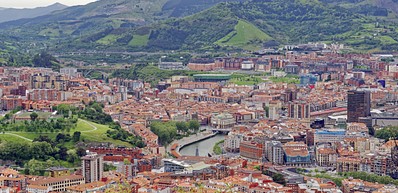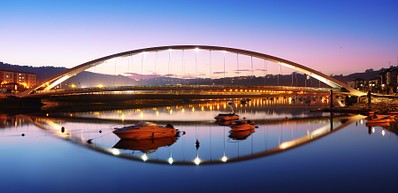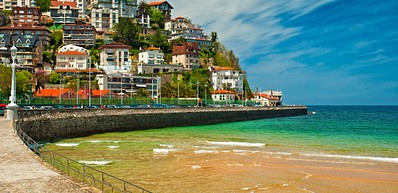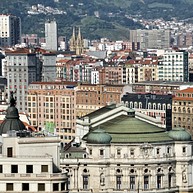
-
![Arriaga Theatre in the city of Bilbao]() Provided by: Santiago Rubio Marcos/Shutterstock.com
Provided by: Santiago Rubio Marcos/Shutterstock.com

Our travel guides are free to read and explore online. If you want to get your own copy, the full travel guide for this destination is available to you offline* to bring along anywhere or print for your trip.
*this will be downloaded as a PDF.Price
€4,95
Arriaga Theatre
The guide was updated:The original theatre, created by Joaquin Rucoba (also known as the Spanish Mozart), burned down in 1914 and a second one was built, resembling the Opera House in Paris. Today, it remains the major cultural venue of Bilbao.
Beautifully located on the banks of the Nervión river, the theatre is host to world-class opera, classical music concerts, and ballet. Besides shows, you can also take a guided tour behind the scenes and see the opera costume collection and the stunning stalls.
Useful Information
- Address: Arriaga Plaza 1, Bilbao
- Website: www.teatroarriaga.eus
- Phone: +34 944 79 20 36
- Email: informacion@teatroarriaga.eus
Digital Travel Guide Download
Our travel guides are free to read and explore online. If you want to get your own copy, the full travel guide for this destination is available to you offline* to bring along anywhere or print for your trip.
*this will be downloaded as a PDF.Price
€4,95

From the ultra-modern Conference Centre and Concert Hall Palacio Euskalduna Jauregia, walk east along the riverbank, which is filled with beautiful sculptures and some very impressive modern architecture. You will pass the Guggenheim Museum and Santiago Calatrava’s stunning Zubi Zuri Footbridge, which spans the Nervión river between the Guggenheim and the Ayuntamiento.
Read more

Basque Archaeological, Ethnographic & Historical Museum
The Museo Arqueológico, Etnográfico e Histórico Vasco, or simply The Basque Museum, is a cosy little museum in Plaza Unamuno, at the heart of the Old Town. This is a great place to visit on a rainy day before or after an aperitif of pintxos and drinks in the nearby bars of Casco Viejo. Learn about the ins and outs of Basque history, culture, and language in this three-storey museum and let yourself in for a journey from the Paleolithic to the present day. Most of the signs are in Basque and Spanish, although rooms have leaflets in English with translations of some of the signage.
Read more

Old Port — Algortako Portu Zaharra
Effectively a tiny fishing village in the midst of a city, the Old Port of Algorta in Getxo is made up of a handful of houses by the shore. It is one of the main attractions in the area, only 20 minutes away from the centre of Bilbao by metro. The Old Port makes for a very pretty and charming setting on a summer's day. A stone's throw away from the beach, the charming white houses follow a downward path to the water. Come sunset, the locals gather outside in the gentle summer breeze to enjoy a beer or two, along with a plate of green olives or crispy fried calamari from the nearby bars.
Read more

Climbing Pagasarri & Ganekogorta
Take a sneak peek at a day in the life of a local by going on one of the most typical and easily accessible hiking routes in the region. Reaching some 673 metres (2,208 feet) in height, Pagasarri is one of the smaller mountains that surround Bilbao and most locals will have tried this hike at least once before. There are buses from the city centre, with a few different routes starting from the area of Zabalburu or from Peñascal, on the outskirts of the city. At the top of the mountain, there is even a bar selling 'bokatas', the typical no-nonsense baguette rolls filled with your local delicacy of choice, from tortilla de patata to txistorra or chorizo. If you've reached the summit of Pagasarri, you're already halfway to Ganekogorta, a summit at 998 metres (3,274 feet) which is a little further away.
Read more

Chillida-Leku
Located in the city of Hernani, at a one-hour distance from Bilbao, Chillida-Leku is an open-air museum exposing the works of Basque sculptor Eduardo Chillida. More than 40 of his pieces are now on display across 27 acres of land, even material that was previously not available to the public. Plus, a restored farmhouse and an organic café.
Read more

Gaztelugatxe (Bermeo)
Gaztelugatxe has become famous as a filming location for the TV series "Game of Thrones", where it is depicted as the castle of Dragonstone. The rough coast has shaped rocks, tunnels, and caves which now form fascinating scenery. On top of a rock, there is a small church, dating back to the 10th century, which can be reached via a narrow path. Gaztelugatxe belongs to the municipality of Bermeo and is only a 45-minute drive away from Bilbao.
Read more

Guggenheim Museum
The Guggenheim Museum Bilbao only opened in 1997, but it has since become one of the most revered and celebrated buildings in the world. The museum's collection focuses primarily on 20th-century American and European art.
Just like the popular saying, it's not just the outside that counts, but it's pretty important for this museum. Architect Frank Gehry designed the building with the vision of ''letting the randomness of the curves catch the light". After the opening of the museum, the building was said to be one of the masterpieces of the 20th century.
Read more

Museum of Fine Arts
The Museo de Bellas Artes has an exceptional collection of traditional works by well-known masters, such as El Greco, Goya, Gauguin, Francis Bacon, Picasso, and Velazquez. The era of the collection begins in the Middle Ages all the way to the contemporary art of today.
The museum has been around since 1908 and started as one of the first Fine Art museums in the world. The popularity of the museum caused the extension of the building with another part in which the rest of the art could be displayed.
Read more

Museum of Religious Art
This museum used to be a former convent, founded in 1515. It contains an intriguing selection of religious art and crafts dating back to the 12th century, including religious silverware, sculptures, paintings, and ceramics by Basque artists. The permanent exhibition is divided into three large sections: sculptures and paintings, gold work, and garments and ornament.
Read more

Itsasmuseum — Bilbao Maritime Museum
Itsasmuseum is the place to uncover Bilbao's past as a shipbuilding and seafaring hub. Outside there are striking floating exhibits with special exhibitions.
The exhibitions are structured around three main themes: the physical environment of the estuary, the evolution of trade in Bilbao, and the development of shipbuilding in the Bilbao estuary. One of the most striking features is the many mini-ships made entirely out of wood, with incredible attention to detail.
Read more

Arriaga Theatre
The original theatre, created by Joaquin Rucoba (also known as the Spanish Mozart), burned down in 1914 and a second one was built, resembling the Opera House in Paris. Today, it remains the major cultural venue of Bilbao.
Beautifully located on the banks of the Nervión river, the theatre is host to world-class opera, classical music concerts, and ballet. Besides shows, you can also take a guided tour behind the scenes and see the opera costume collection and the stunning stalls.
Read more

The Vizcaya Bridge
Just outside Bilbao, in the province of Biscay is one of the city's main attractions: Puente de Vizcaya, also known as Puente Colgante or Hanging Bridge. There are two ways of crossing it, both with equally dramatic views: the first is by gondola cable car and the second by walking along the pedestrian path.
If you are still not convinced, the bridge has been declared a World Heritage Site by UNESCO for being the 'perfect combination of beauty and functionality'.
Read more

Plaza Nueva (Plaza Barria)
There are 64 arches around this enclosed square, which is the oldest surviving square in town. Built in 1849, it’s a perfect place to stop and sip a cup of coffee while you watch the world go by. This plaza is home to some of the best and most up-market pintxos in the area. One of the cafés that you can try is the famous Café Bar Bilbao. Sure, the name is not very original, but it is known for its finger-licking pintxos. Look out for the squid pintxo, as well as the ham and onion one. These are the two specialities of the house.
Read more

Artxanda Viewpoint
If you want to escape the city streets, this is the right place for you to take in a breath of fresh air and look down at Bilbao from above. At the Artxanda viewpoint, you can enjoy a magnificent panoramic view of the city and the beautiful mountains that surround it. There is a small funicular railway that functions as a fast mode of transportation to reach the top of the hill.
Read more

Plentzia
Plentzia is a happening resort just outside Bilbao, in the province of Biscay. Located atop a hill, its streets pour down the hillside leading to lovely sandy beaches. Plentzia is a popular weekend destination from Bilbao, as it takes a short 30 minutes to get there on the overground metro service from the centre of Bilbao. In the town of Plentzia, there are plenty of bars and cafés which serve locally caught fresh seafood.
The town also has an indoor court for the sport of Basque pelota. Here you can watch this traditional game, which involves two teams of players who hurl a small hard white ball at a wall swinging at it with the full force of the palms of their bare hands.
Read more

Day Trip to Donostia — San Sebastián
This is a city set between two hills around the beautiful bay of La Concha. San Sebastian, or Donosti as it is known by the locals, makes for an unforgettable day trip, where you can take in the glorious Belle Epoque balustrades and visit world-famous restaurants.
There are four areas that you should visit. The first one is Parte Vieja, the Old Town, where you can find the popular pintxo bars and eat til you drop. South of Parte Vieja, you'll find the shopping district and heading towards the coast you will come across three beaches: Zurriola, the preferred spot for local surfers, La Concha, and Ondarreta, where the posh neighbourhood is.
Read more

Doña Casilda Iturrizar Park
The Doña Casilda Iturrizar Park is the city's largest green space located by Paseo Don Jose Anselmo Clavé, next to the Museum of Fine Arts. The park was built in 1907 by an architect called Ricardo Bastida. Strolling through this park you will come across a water fountain, a basketball court, and a pavilion for live performances.
If the directions are unclear, you can always try asking a local for 'el parque de los patos', or the park with the ducks, as it is affectionately nicknamed.
Read more

Basilica of Begoña
You will find the Basilica of Begoña at Calle Virgen de Begoña on the top of a hill. The church construction started in 1511 and it is widely held that the Virgin Mary appeared at that exact spot. You can see that the church is still important to the sailors of Bilbao. There are still ships which are named after the church, Virgen de Begoña or just Begoña–the patron saint of Biscay. Experience history first-hand when you walk through the doors of this basilica.
Read more

Zubizuri Bridge
The white structure of the impressive pedestrian bridge over the Nervion River can be seen from far away on a sunny summer’s day in Bilbao. It's extra special since the bridge was designed to look like a sailboat, ten metres above the river.
Zubizuri connects Campo Volantín Boulevard with Uribitarte, and from the bridge, you have a stunning view of the Guggenheim Museum. There used to be a glass floor, but after complaints, the city decided to place a non-slip mat. So even on a rainy day, you can walk there safely.
Read more

Santiago Cathedral
The Santiago Cathedral is a Roman Catholic church in Bilbao. The temple is consecrated in honour of the apostle Saint James the Great–Santiago in Spanish–the patron of Bilbao. The Gothic architecture dates back to the 15th century, which makes it the oldest church in Bilbao. It has been renewed several times throughout the years. There are several reasons why this is such a peculiar church. For instance, it's not built in one style, but a combination of three. There is a Gothic cloister, a Renaissance portico, and a neo-Gothic spire.
Read more

Azkuna Zentroa — Alhóndiga Bilbao
This old warehouse has been renovated to become one of Bilbao's most vibrant cultural venues. There are activities for everyone, from exhibitions to cinemas, kids' activities, concerts, lectures and a library–the 43,000 square meter space has it all. If you get hungry during your visit, it provides several opportunities for refreshments to your liking.
In 2015, the building, previously known as Alhóndiga Bilbao, was renamed Azkuna Zentroa in tribute to the late mayor of Bilbao, Iñaki Azkuna, who changed the industrial Bilbao into a cultural masterpiece.
Read more

Campos Elíseos Theatre
This stunning Art Nouveau theatre is worth a moment of your time. It was established in 1901 and reopened in 2010 after renovation. You can get a free guided tour through the highlights of the building, and the theatre's program is very interesting as well. Campos Elíseos hosts national and international artists and performers, which promise to provide a spectacular evening and will leave you breathless with amazement.
Read more


